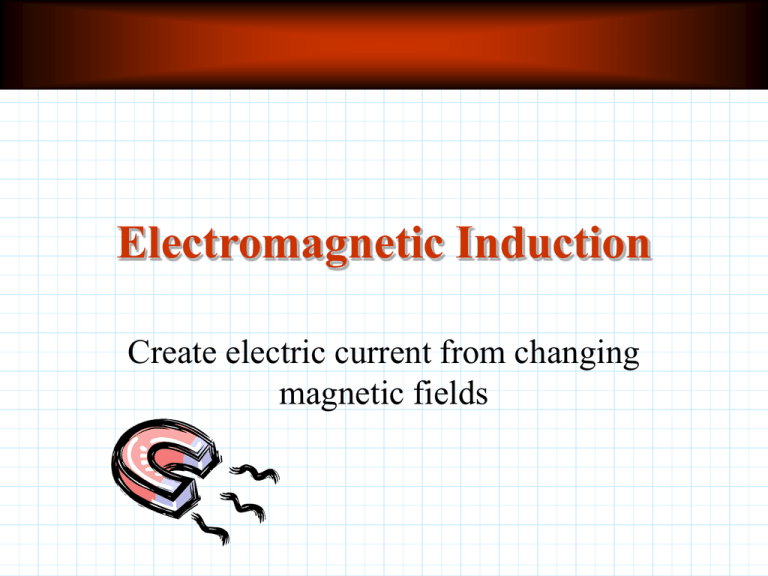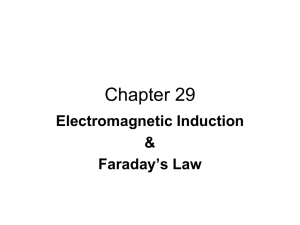Introduction
advertisement

Electromagnetic Induction Create electric current from changing magnetic fields Objectives Explain how a changing magnetic field produces an electric current Define electromotive force and solve problems involving wires moving in a magnetic field Describe how an electric generator works and how it differs from a motor Recognize the difference between peak and effective voltage and current Objectives State Lenz’s Law and explain “back-EMF” and how it affects the operation of motors and generators Explain self-inductance and how it affects circuits Describe a transformer and solve problems involving voltage, current, and turns ratios Electromagnetism Force on a moving charged particle in a magnetic field Force on a current-carrying wire in a magnetic field Voltage (and current) induced in a wire forced to move in a magnetic field Voltage (and current) induced by a changing magnetic field Basis of motors and generators, and electromagnetic waves Electromagnetic Induction Faraday’s Law Lenz’s Law The AC Generator The DC Generator Back EMF in a Motor The Transformer Faraday’s Law Faraday’s Law: Moving a conductor through magnetic flux lines causes an emf to be induced in the conductor. • Relative motion between a conductor and a magnetic field induces an emf in the conductor. • The direction of the induced emf depends on the direction of motion of the conductor with respect to the field. • The magnitude of the emf is directly proportional to the rate at which magnetic flux lines are cut by the conductor. • The magnitude of the emf is directly proportional to the number of turns of the Textbook, Pg. 582 conductor crossing the flux lines. N t Induced Voltage Voltage induced in a wire moving perpendicular to a magnetic field E = induced voltage (electromotive force) B = magnetic field strength L = length of wire v = velocity of wire moving perpendicular to magnetic field E BLv Induced Voltage EMF Induced by a Moving Wire An emf is induced in a wire that is moving perpendicular to a magnetic field. Where: = the induced emf B = strength of the magnetic field l = length of the wire v = velocity of motion q = angle of the wire relative to the flux lines Blvsin q Example A straight wire 0.20 m long moves at a constant speed of 7.0 m/s perpendicular to a magnetic field of strength 8.0 x 10-2 T What EMF is induced in the wire? The wire is part of a circuit that has a resistance of 0.50 Ω. What is the current through the wire? Known: v = 7.0 m/s L = 0.20 m B = 8.0 x 10-2 T R = 0.50 Ω Unknown: EMF = ? (V) I = ? (A) EMF BLv c hb ge j 8.0 x102 T 0.20m 7.0 m s 011 . V Textbook, Pg. 584-5 V EMF Practice Problems 1-4 I R R 011 . V 0.22 A counterclockwise 0.50 The AC Generator An electric generator converts mechanical energy into electric energy. The three main components are: a field magnet an armature slip rings with brushes If the armature is rotating with a constant angular velocity in a constant magnetic field, the magnitude of the induced emf and current varies sinusoidally with respect to time. inst maxsin 2ft iinst imaxsin 2ft “Effective” Current & Voltage Power is the product of voltage and current Both vary with an alternating current Average power is half the maximum “Effective” current and “effective” voltage Equivalent constant voltage and current that would generate the same average power Veff2 Pavg 1 2 Pmax I eff2 R R 2 I eff2 R 1 2 I max R I eff 1 2 I max I eff 0.707 I max Likewise, Veff 0.707Vmax Textbook, Pg. 588-9 Practice Problems 5-8 The DC Generator A simple ac generator can be converted easily to a dc generator by substituting a split-ring commutator for the slip rings. Lenz's Law Lenz’s Law: An induced current will flow in such a direction that it will oppose by its magnetic field the motion of the magnetic field that is producing it. Fleming’s Rule: If the thumb, forefinger, and middle finger of the right hand are held at right angles to each other, with the thumb pointing in the direction in which the wire is moving and the forefinger pointing in the field direction (N to S), the middle finger will point in the direction of induced conventional current. Textbook, Pg. 590 Back EMF in a Motor • In an electric motor, a magnetic torque turns a currentcarrying loop in a constant magnetic field. • A coil rotating in a magnetic field induces an emf that opposes the cause that gave rise to it. • Thus, every motor is also a generator. According to Lenz's law, such an induced emf must oppose the current delivered to the motor. For this reason, the emf induced in a motor is called back emf or counter emf. The Transformer The basic parts of a simple transformer are: A primary coil connected to an ac source. A secondary coil connected to a load. primary voltage primary turns A soft iron core. secondary voltage secondary turns A transformer that produces a higher secondary voltage is called a step-up transformer. p Np s Ns A transformer that produces a lower secondary voltage is called a step-down transformer. Textbook, Pg. 594 New Terms induced emf ac generator dc generator electromagnetic induction back emf step-up transformer step-down transformer transformer efficiency Equations N t Blvsin q inst maxsin 2ft iinst imaxsin 2ft primary voltage primary turns secondary voltage secondary turns p Np s Ns Summary Michael Faraday discovered that if a wire moves through a magnetic field, an electric current can flow The current produced depends upon the angle between the velocity of the wire and the magnetic field Maximum current occurs when the wire is moving at right angles to the field Electromotive force (EMF) is the potential difference created across the moving wire EMF is measured in volts Continued on next slide Summary The EMF in a straight length of wire moving through a uniform magnetic field is the product of the magnetic field (B), the length of the wire (L), and the component of the velocity of the moving wire (v), perpendicular to the field A generator and a motor are similar devices A generator converts mechanical energy to electrical energy A motor converts electrical energy to mechanical energy Continued on next slide Summary Lenz’s Law states that an induced current is always produced in a direction such that the magnetic field resulting from the induced current opposes the change in the magnetic field that is causing the induced current Self-inductance is a property of a wire carrying a changing current The faster the current is changing, the greater the induced EMF that opposes that change Continued on next slide Summary A transformer has two coils wound about the same core An AC current through the primary coil induces an alternating EMF in the seondary coil The voltages in alternating-current circuits may be increased of decreased by transformers Credits •Physics, Sixth Edition •Paul E. Tippens •Physics: Principles and Problems •Paul W. Zitzewitz





